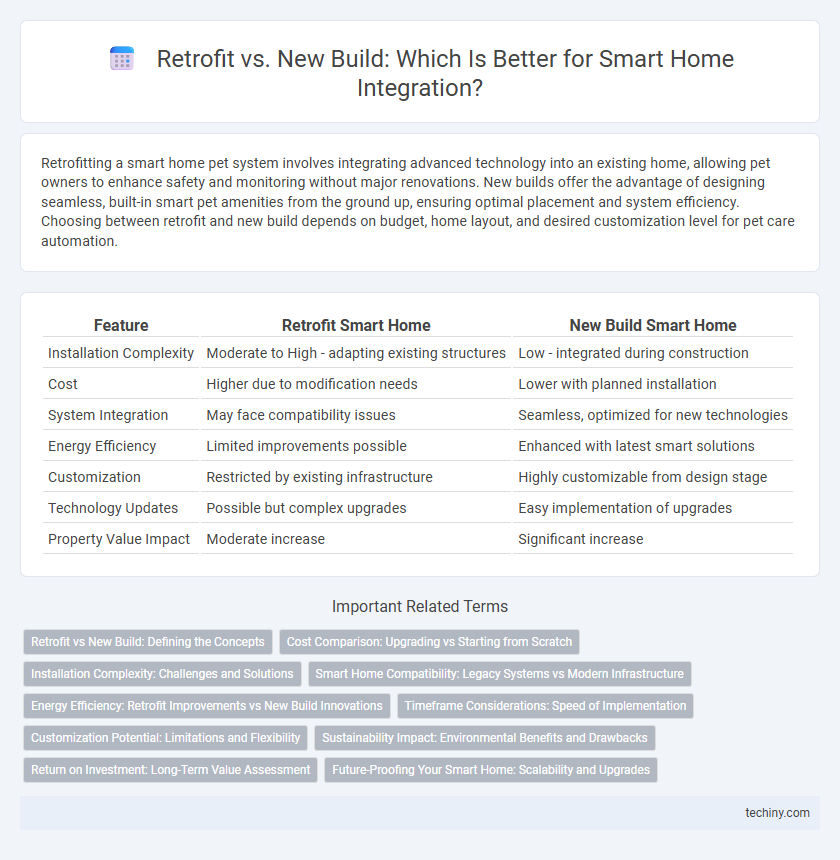Retrofitting a smart home pet system involves integrating advanced technology into an existing home, allowing pet owners to enhance safety and monitoring without major renovations. New builds offer the advantage of designing seamless, built-in smart pet amenities from the ground up, ensuring optimal placement and system efficiency. Choosing between retrofit and new build depends on budget, home layout, and desired customization level for pet care automation.
Table of Comparison
| Feature | Retrofit Smart Home | New Build Smart Home |
|---|---|---|
| Installation Complexity | Moderate to High - adapting existing structures | Low - integrated during construction |
| Cost | Higher due to modification needs | Lower with planned installation |
| System Integration | May face compatibility issues | Seamless, optimized for new technologies |
| Energy Efficiency | Limited improvements possible | Enhanced with latest smart solutions |
| Customization | Restricted by existing infrastructure | Highly customizable from design stage |
| Technology Updates | Possible but complex upgrades | Easy implementation of upgrades |
| Property Value Impact | Moderate increase | Significant increase |
Retrofit vs New Build: Defining the Concepts
Retrofit involves upgrading an existing home with smart technology, optimizing current infrastructure to enhance automation, energy efficiency, and security without extensive reconstruction. New build smart homes integrate intelligent systems from the ground up, allowing seamless design and advanced connectivity tailored to modern standards. Understanding the distinction between retrofit and new build is crucial for planning smart home installations based on budget, timeline, and technical constraints.
Cost Comparison: Upgrading vs Starting from Scratch
Retrofitting a smart home typically involves lower upfront costs, as it leverages existing infrastructure and wiring, reducing labor expenses significantly compared to new builds. New build smart homes, while more expensive initially due to full installation of integrated systems, provide better long-term efficiency and seamless device compatibility. Homeowners must weigh initial retrofit savings against potential future expenses related to system upgrades and limitations inherent in older constructions.
Installation Complexity: Challenges and Solutions
Retrofit smart home installations often face higher complexity due to existing structures limiting wiring options and integration with legacy systems, requiring customized solutions like wireless sensors and modular controllers. New build projects benefit from planned infrastructure, allowing seamless integration of smart devices with pre-installed conduits and unified control hubs, reducing installation time and cost. Advanced technologies such as mesh networking and battery-operated smart devices address retrofit challenges, enabling scalable, minimally invasive smart home upgrades.
Smart Home Compatibility: Legacy Systems vs Modern Infrastructure
Retrofit smart home systems often face compatibility challenges with legacy wiring and outdated infrastructure, requiring specialized adapters or gateways to integrate modern devices effectively. New build homes benefit from advanced smart home compatibility, featuring pre-installed networking frameworks like structured Ethernet cabling and integrated IoT hubs designed for seamless device interoperability. Investing in modern infrastructure enhances system reliability, future-proofing smart home functionality against rapid technological advancements.
Energy Efficiency: Retrofit Improvements vs New Build Innovations
Retrofit projects enhance energy efficiency by upgrading insulation, installing energy-efficient windows, and integrating smart thermostats, effectively reducing energy consumption in existing homes. New builds incorporate cutting-edge innovations like passive house standards, advanced HVAC systems, and renewable energy integrations, achieving superior energy performance from the outset. Both approaches significantly lower carbon footprints, but new builds offer greater potential for seamless incorporation of smart home energy technologies and long-term sustainability.
Timeframe Considerations: Speed of Implementation
Retrofitting a smart home system typically requires more time due to the integration with existing structures and the need to work around established wiring and layouts. New builds allow for faster implementation since smart technologies can be seamlessly incorporated during construction, reducing installation complexity and delays. Project timelines for retrofits often extend weeks longer compared to new builds, impacting overall speed of deployment.
Customization Potential: Limitations and Flexibility
Retrofit smart home installations often face customization limitations due to existing wiring, structural constraints, and compatibility with older systems, restricting flexibility in device placement and integration. New build smart homes provide extensive customization potential, allowing seamless integration of advanced automation, tailored sensor layouts, and future-proof infrastructure designed for optimal connectivity. Choosing new builds enhances adaptability and scalability, whereas retrofits require careful planning to maximize functionality within physical and technological constraints.
Sustainability Impact: Environmental Benefits and Drawbacks
Retrofitting smart home technologies in existing buildings reduces construction waste and preserves embodied energy, significantly lowering the environmental impact compared to new builds. New builds offer opportunities to integrate advanced sustainable materials and energy-efficient designs from the ground up, enhancing long-term environmental benefits. However, the initial carbon footprint of new construction remains higher due to resource-intensive processes and manufacturing emissions.
Return on Investment: Long-Term Value Assessment
Retrofitting a smart home often offers a quicker return on investment by enhancing existing infrastructure without extensive construction costs. New build smart homes incorporate integrated technologies from the ground up, delivering higher long-term value through seamless automation and energy efficiency. Evaluating energy savings, maintenance expenses, and property value appreciation is critical when assessing the ROI between retrofit and new build smart home projects.
Future-Proofing Your Smart Home: Scalability and Upgrades
Retrofitting a smart home offers immediate integration of advanced technology but may face limitations in scalability and future upgrades due to existing infrastructure constraints. New builds provide a flexible foundation designed with future-proofing in mind, enabling seamless incorporation of evolving smart systems and enhanced scalability. Prioritizing modular and interoperable smart devices ensures adaptability to technological advancements, maximizing long-term value and user convenience.
Retrofit vs New Build Infographic

 techiny.com
techiny.com